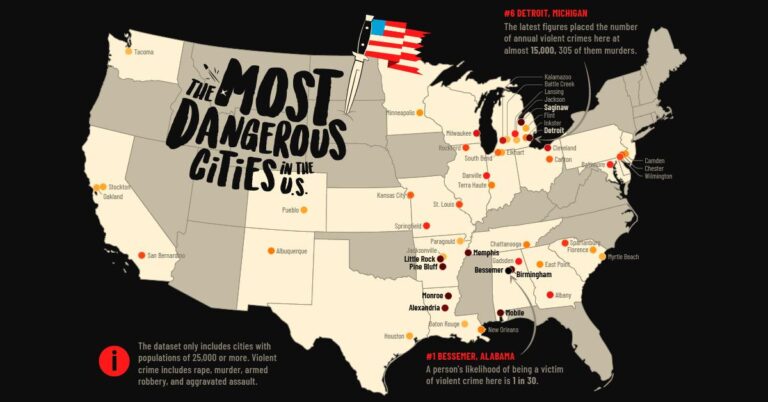Analyzing the Most Hazardous Cities in the United States: A Deep Dive into Urban Crime and Safety
Identifying the Most Crime-Ridden Neighborhoods in U.S. Metropolitan Areas
Recent findings from Security.org provide an in-depth evaluation of crime prevalence across American cities, spotlighting neighborhoods where violent offenses such as assaults, robberies, and homicides are disproportionately high. These areas often overlap with communities facing economic hardship, educational deficits, and scarce social services. Urban centers like Chicago, Detroit, and Baltimore repeatedly emerge as focal points of concentrated violence, posing significant challenges for residents and local authorities.
Crime distribution within cities is typically uneven, with violence clustering in specific districts rather than being uniformly spread. A detailed examination of these hotspots reveals the following neighborhoods as some of the most affected by violent crime:
- Chicago: Englewood and West Garfield Park
- Detroit: East Side and Southwest Detroit
- Baltimore: West Baltimore and Cherry Hill
- St. Louis: North City and Wells-Goodfellow
- Philadelphia: Kensington and North Philadelphia
| City | Neighborhood with Highest Violent Crime | Violent Crime Rate (per 1,000 residents annually) |
|---|---|---|
| Detroit | East Side | 48.2 |
| Baltimore | West Baltimore | 47.7 |
| Chicago | Englewood | 42.5 |
Key Contributors to Elevated Crime Rates in Urban Settings
The prevalence of crime in metropolitan areas stems from a multifaceted combination of social, economic, and environmental influences. Foremost among these are poverty and joblessness, which often create fertile ground for criminal behavior. Neighborhoods with scarce employment prospects tend to experience higher incidences of theft, drug offenses, and violent acts. Additionally, high population density can intensify social friction and competition for limited resources, further exacerbating crime rates.
Additional significant elements impacting crime include:
- Educational and social service availability: Limited access is linked to increased criminal activity.
- Community policing and engagement: Cities with strong law enforcement-community partnerships typically see reduced violence.
- Housing stability: Frequent moves and homelessness contribute to social disorder and insecurity.
| Factor | Effect on Crime | Representative Cities |
|---|---|---|
| Poverty Levels | Strongly linked to both violent and property crimes | Detroit, Baltimore |
| Law Enforcement Strategies | Community-focused policing reduces crime rates | New York, Seattle |
| Access to Education | Long-term crime reduction through improved opportunities | Boston, Minneapolis |
Practical Safety Tips for Residents in High-Crime Areas
For those living in neighborhoods identified as high-risk, prioritizing personal security is essential while maintaining everyday routines. Simple yet effective precautions include securing all entry points, steering clear of isolated areas after dark, and minimizing behaviors that might attract unwanted attention. Staying updated on local crime developments through community apps or neighborhood watch groups empowers residents to anticipate and avoid potential threats.
- Use motion-activated lighting around your home’s exterior
- Participate in or organize neighborhood watch programs
- Be cautious about sharing daily routines on social media platforms
- Keep a mobile phone handy with emergency contacts pre-saved
Collective vigilance is equally important. When community members collaborate to report suspicious activities, engage in safety workshops, and advocate for increased police presence, they foster a safer environment. This synergy between individual awareness and communal action can transform vulnerable neighborhoods into more secure living spaces.
Innovative Community and Policy Efforts to Enhance Urban Safety
Across the country, municipal leaders and grassroots organizations are implementing focused initiatives to reduce crime and rebuild trust within communities. Programs range from neighborhood watch networks to improved street lighting projects, emphasizing prevention and local involvement. In cities like Detroit and Baltimore, community centers serve as vital resources offering youth programs, vocational training, and mental health services aimed at steering individuals away from criminal paths. Concurrently, law enforcement agencies are adopting data-driven approaches to target crime hotspots while fostering positive relationships with residents.
Policy changes are also playing a transformative role. Many cities are revising sentencing guidelines and investing in rehabilitation to lower repeat offenses. Housing-first models, which prioritize stable living conditions, are gaining traction as a key strategy in crime reduction. Below is a snapshot of some impactful community programs currently active in cities with significant safety challenges:
| City | Program | Primary Focus | Results |
|---|---|---|---|
| St. Louis | Safe Passage Network | Youth Protection & Education | 30% decrease in juvenile crime |
| Chicago | CeaseFire Initiative | Violence Interruption | 40% reduction in shooting incidents |
| Baltimore | Community Policing Program | Strengthening Police-Community Relations | Enhanced trust and cooperation |
Final Thoughts on Urban Crime and Safety
Gaining insight into the cities with the highest crime rates is vital for residents, decision-makers, and visitors. The comprehensive analysis by Security.org highlights the multifactorial causes behind urban crime and underscores the importance of targeted strategies and community involvement. As urban landscapes continue to change, sustained vigilance combined with evidence-based policies will be key to fostering safer environments and protecting the well-being of all Americans.




